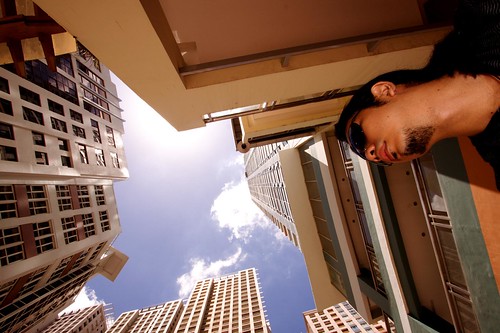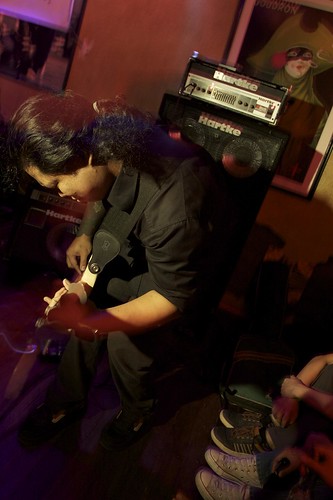It’s now almost exactly 90 days since I bought the Canon 50D along with a bag full of gear, and if you’ve been following me in other than this blog, you’re probably already be very much aware (possibly to the point of discomfort) of how much photography has interpolated itself into my life. So here I am, listing down a grab-bag of various photographic truisms that I’ve come to understand over these first three months with a DSLR. I’m very new to all this, so many of the things on this list – indeed, likely all of them – will be common-knowledge to more experienced photographers. Please also be aware that I’ll be using my own work as examples throughout this piece, not for any reason other than that I need constant, unswerving affirmation that I’m not a total newb.
Also, I like lists. So should you.
1. Holy shit, Nikon really is better than Canon.
Ok, so let’s get the controversial item out of the way first: the more I improve, the more I wish I had gone with a Nikon body instead of a Canon one. Although this is arguably a consequence of my shooting style (i.e., to light the shit out of everything), in a much larger sense, it’s because Nikon is at the forefront of camera technology right now. I’m talking specifically about the Creative Lighting System here, which is built-in on most of their high-end cameras. Now, I’ve never personally used CLS because I’ve never used a Nikon system, but the fact that there’s no way to mimic it – even on paper, theoretically – with a Canon system says a whole frickin’ lot. Sure you can fire a flash wirelessly with any DSLR, but not without a bunch of external accessories. And there’s no way to manually-set your flashes wirelessly from your camera, which is a big deal when you’re working in a tight space and your flashes aren’t easy to reach. (There’s a longer discussion on this matter here, if you’re interested, and an even longer dissertation by the great Ken Rockwell here. There are specific situations, to be fair, where the Canon rigs shine, but in terms of flexibility and simplicity, it’s no contest.)
2. Av Mode = 95%
Nearly every pro I’ve read about defaults to Aperture-priority mode, and not full manual mode, 95% of the time when shooting. The theory behind it is that you’re generally more interested in controlling depth of field, than stopping motion (which would be the opposite mode, Shutter-priority). Even if you’re one of those guys who shoots nothing but running children all day long, opening up your aperture will have the effect of giving you fast shutter speeds anyway.
Why not manual though? Because it’s silly to spend several thousand dollars on a sophisticated camera system only to make all the menial decisions yourself. If you’re shooting a landscape in the daytime, you probably already know that you’re going to be closing down to F/16, punching in a low ISO and kicking up your shutter speed. Guess what, so does the camera, but you’ll do it slower. (Note that I said 95% of the time. The other 5% is for the scenarios that really require a human’s creative direction, which is when you would go full manual.)
3. Security guards are not your friends
The only place I feel relatively free to take as many images as I want are in small gig venues like Magnet, 6 Underground or Route 196, or on vacation at the beach. In nearly every other place I’ve spent any amount of time shooting at, the sight of a big DSLR (and especially a tripod) is enough to send building security into conniptions. It turns out that they are strangely blind to handheld point-and-shoots and gorillapods though. Because of this, I’ve learned to only whip the camera out when I already know what I’m shooting, as opposed to walking around with my lens against my face.
4. Noise < Shake
Trying to take a picture in lowlight will usually result in one of two things: excessive amounts of noise in your picture, or a blurry image due to camera shake. The noisiness would be due to the high-sensitivity ISO you picked to capture as much of the scene as possible, while the camera shake would be due to you forcing a low ISO and thus being forced to handhold your camera at un-handholdable shutter speeds. Traditionally, 1/60 is about the lowest shutter speed you can go without the aid of a strobe (see #6). However, advances in lens technology (Image Stabilization in Canon, and Vibration Reduction in Nikon) has allowed us to bend this rule slightly and still get great results at 1/40.
Now, if you happen to find yourself in a lowlight situation and you have a choice between kicking your ISO up to 3200 or throwing your shutter speed down to 1/10, choose the former. Allow your image to noise it up. It won’t look pretty on your LCD, but as per renowned local photographer Jo Avila, “There are plenty of ways to reduce digital noise in Photoshop, but there’s no way to fix camera shake.”
5. Photography is not about showing what was there …
It’s about showing what you saw there. It’s a small difference, and I’ll make the effort not to wax too poetic here. People sometimes think that photography should be honest; in other words, it should capture a scene as it was, with little grooming or primping. This is because they confuse photography (in general) with photojournalism (specifically). In the words of the legendary natural-light photographer Jay Maisel, “The very nature of photography has always been to resemble something, but not to be identical to it.”
Part of the reason why I’m starting to really get into lighting is because it lets me emphasize the stuff I’m interested in within a scene while diminishing everything else. Here’s an example, featuring of one of my favorite local bands, .

Mica has played bass for Sleepwalk with a distinctly stoic expression on her face every single time I’ve seen her, and I wanted to capture her doing something, anything else just once. In this frame, her mouth opened slightly. OH. MY. GOD.
Jokes aside though, throwing the strobe at just her face forces everything else in the image to become secondary. You can still see the bass, and you can tell that you’re seeing a 105.9 event, but the point of the image is clearly to highlight her facial expression. Or in this case, the lack thereof.
This brings me rather conveniently to my next point, which is largely a technical one:
6. Get that strobe off your camera!
The whole emphasizing/de-emphasizing strategy is really hard to pull off if your strobe is attached to your camera. If your light is always going to be coming from 4 inches above your lens, the chances that you’re going to be able to do anything fancy is going to be pretty limited. This is why I feel so strongly about #1, because Nikon’s CLS would let me do this, with no additional commander unit and no extra batteries. With Canon, we’re talking about an additional US$200 device, at the minimum, or a whole new bag of radio triggers, cables and battery packs if you want to go all-out.
Here’s a fun image from last night to illustrate, featuring Gelo Lagasca of :

If you’ve ever been to Sa Guijo in Makati, you’ll know that there’s no spotlight in that bar from that angle. In fact, there are no lights at all coming from that side; the lead singer’s left is almost completely in darkness. The “spotlight” is actually a single strobe that I’m holding in my left hand while shooting with my right.
Here’s another strobe trick, featuring Edong Bareng, also from the Lowtechs:
Strobe coming from high above, my camera at eye-level. As he swoops downwards, you release your shutter, and everything that the flash hits is frozen in sharp focus. Everything else will blur or be visually diminished. This is because the speed of your flash is so much faster (1/1000th of a second or more) than your shutter that it can usually only illuminate the subject either at the beginning of the exposure or at the end. It’s this quirk that allows you to handhold your camera at speeds less than 1/40 without experiencing excessive camera shake. (I believe my shutter was at 1/4 for this image.)
7. Gear makes a big difference
That title, btw, is cribbed from Scott Kelby’s The Digital Photography book. Many people argue that equipment is secondary to photographer skill, citing examples of photographers with five-dollar cameras winning awards and all sorts of accolades. While I don’t disagree that that’s possible, I will point out that for every one photographer who takes award-winning, one-of-a-kind photos with 5-dollar cameras, there are 99,999 photographers who take them with 5,000-dollar camera systems. If you consider yourself to be an auteur of that level (one in a hundred thousand), then by all means, take your 5-dollar camera out and kick everyone’s ass with it. Scott Kelby puts this another way:
Give Jay Maisel a point-and-shoot, and he’ll take point-and-shoot shots that could hang in a gallery, but the problem is, we’re not as good as Jay Maisel.
Now, I don’t mean that you should buy every piece of equipment you can get your hands on. There’s a deliberate, cognizant path to accumulating the proper camera system over time, and it really depends on where your various photographic interests lie. Unfortunately, I didn’t take that path myself and instead bought as much stuff as I could get my greedy little paws on early on. Apart from the fact that it took a good long while before I learned how to use all that crap, I also ended up amassing things I didn’t need. I’ve taken steps to fix this now though, selling some lens and consolidating my gear as much as I can. But I digress.
I should mention though that nowhere is the aforementioned difference felt more than in the glass. I’ve had the good fortune to play with a couple of Canon L lenses these past weeks and it’s startling how huge the difference in visual acuity is between these and the regular line. Depending on which ones you buy, you could spend anywhere between $700 to a few thousand, but the sharpness, speed of operation and solid build quality is just awe-inspiring.
And as a corollary to this:
8. There are only two types of tripods …
… Those that are easy to carry, and the good ones (as per renowned travel photographer and author Bill Fortney). Advances in high-end tripod technology (carbon fiber bodies, for example) have allowed us to create tripods that you could travel to outer space with, but they haven’t gotten any lighter. This is by design, because you need something that can support your 2- or 3-kilo DSLR/lens package even in the most precarious of positions. Lighter tripods get knocked over by the wind, topple over in uneven terrain, and experience camera shake when you press the shutter.
The other thing about tripods is that they’re the kind of purchase where you absolutely must buy the most expensive one you can afford. The reason is that tripods don’t go through the same cycle of forced obsolence that cameras do. You could buy that US$400 tripod today and still be using it 10 years from now, so if you look at it that way, you’re only really paying $0.10/day for it.
Last one, and then let’s call it a day:
9. Don’t take the obvious shot
Whenever possible: Don’t shoot down at flowers. Don’t shoot up at buildings. Don’t shoot people from eye-level. This is already how 99% of your viewers see the world, and showing them the same thing isn’t photography, it’s reportage. Choosing a different angle can make a normal subject look kinda cool (if I do say so myself :P) :

One of the most magical things about photography is that it freezes time around these small visual miracles that are occurring right under our very noses, and that we would otherwise miss because we just don’t bother to look down:

Or look up:

The way we look at the world is what separates “photographers” from “guys with cameras,” and though I consider myself still more of the latter than the former, I am certainly working hard at the transition.
If you liked this post, check out my Flickr photostream here, and .
[UPDATE] Check out the comments for some important bits of info from other (more experienced) photographers who happened to stumble on this entry. For the sake of fidelity, I’m not going to change anything I wrote in the above piece, so please see the handful of mistakes or misconceptions pointed out by commenters.
